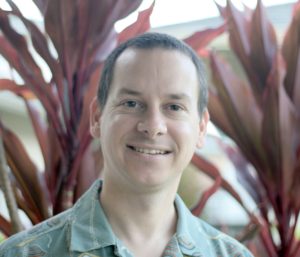Flying a plane into the center of a hurricane might not be everyone’s cup of tea, but for Michael Bell, associate professor in the Department of Atmospheric Science, it is an intense experience that is an integral part of his job. Bell’s work observing and modeling tropical cyclones has earned him a Presidential Early Career Award for Scientists and Engineers (PECASE), “the highest honor bestowed by the United States Government on science and engineering professionals in the early stages of their independent research careers.”

Bell was nominated for the PECASE award by the Office of Naval Research (ONR), with whom he has previously done hurricane and typhoon research. Working with the ONR and colleagues from CSU, Bell is preparing for field work on a new project called Propagation of Intra-Seasonal Tropical Oscillations (PISTON), and is looking forward to being able to utilize the $1 million award to supplement his efforts.
“Receiving this award is wonderful, and I’m just thrilled. I’ve worked with the Navy for many years, and they’ve been great supporters of my research to help improve our ability to predict tropical cyclones,” Bell said.
Bell started working with the Navy in 2007 for an ONR-sponsored project based in Guam called Tropical Cyclone Structure 2008 (TCS08). The project was jointly conducted with the National Science Foundation-sponsored THORPEX Pacific Area Regional Campaign (T-PARC), and was an international effort to better understand typhoons in the Pacific.
Bell received his Ph.D. from the Naval Postgraduate School after that project, and understands the unique forecast challenges faced by the U.S. Navy. Much of his work has been focused in the Pacific, because the area is home to many of the strongest tropical cyclones in the world and is an important area of operations for the Navy.
Observing hurricanes, typhoons and tropical cyclones
Fun fact: hurricanes and typhoons are functionally the same thing; the term “hurricane” is used for storms that occur in the Atlantic and Northeast Pacific, while the term “typhoon” is used for storms that occur in the Northwest Pacific. The term “tropical cyclones” is a universal term used to describe any of these phenomena, and the goal of Bell’s work is to improve the understanding and prediction of these tropical cyclones.
“Tropical cyclones are a big problem for the U.S. Navy, but also for coastal residents of the U.S. and around the globe. We still have difficulties in forecasting them, but we’ve made a lot of progress over the years,” Bell said.
To gather data on these storms and improve understanding of their structure, two of the primary tools Bell uses are Doppler radar and small, lightweight devices called dropsondes. Dropsondes are released from aircraft and collect high-density data as they fall to the surface. During Bell’s most recent ONR project, called Tropical Cyclone Intensity 2015 (TCI15), about 800 sondes were launched from the stratosphere to collect data on Hurricanes Erica, Joaquin, Marty and Patricia. With the information gathered from these sondes, Bell can more accurately create models that anticipate the way a storm will intensify, providing for earlier and better predictions.
“The real frontier of what we’re doing now is combining observations and numerical weather prediction models in really exciting ways. The forefront of my research is trying to merge these two approaches – in the past, many researchers have focused on either models or observations, but you need both,” Bell said.
With the rapid advancement of technology, Bell and other atmospheric scientists are able to observe the atmosphere in new and better ways. Bell is still working on analyzing the data from TCI15 while also preparing for project PISTON, but the next time he rides an aircraft into the center of the storm, he hopes to gather measurements that will bring him even closer to providing more lead time on future hazardous weather.